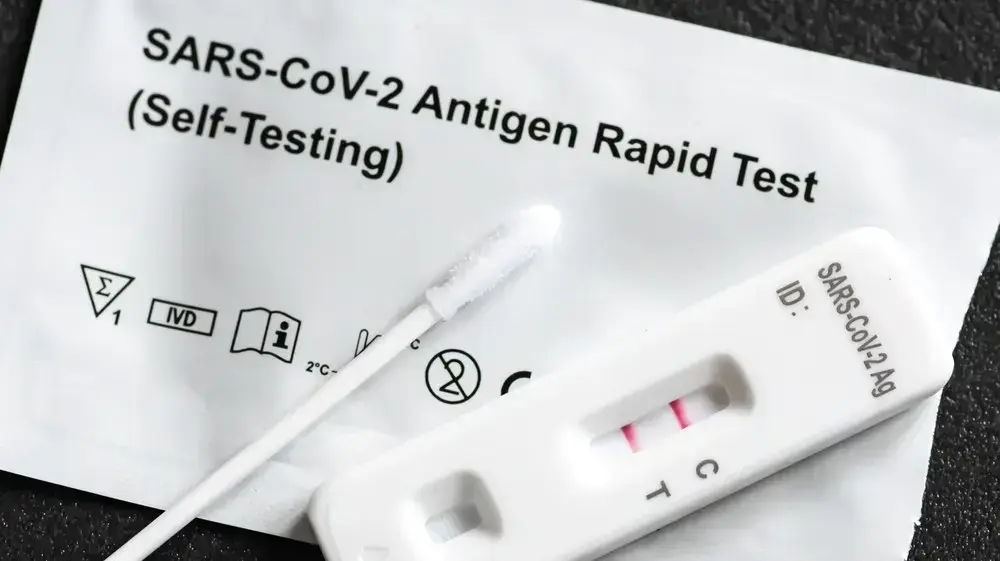Antigen testing is changing the fight against the pandemic.
Its use is multiplying everywhere: in Spain until September they were hardly done, but now they are almost 30% of the tests that are carried out every week.
They are associated with screening, but are already the reference test for patients with symptoms in hospitals and in primary care.
In addition, the European Commission recommends its use also for tracing close contacts, in residences and other sources of contagion.
These tests have two great advantages: they are fast and they are cheap.
They detect proteins (antigens) that allow the identification of patients with an active infection.
A sample is taken by rubbing a swab in the patient's nose and the diagnosis is known in less than half an hour.
The big difference with a PCR, the most used alternative so far, is that you do not have to send the sample to a laboratory to obtain the result.
In the following graph
we can see the evolution of the viral load and the duration of the
infectious phase
in which it is vital to detect positives quickly:
Infectivity
Contagion
S
Day 1
Day 6
Day 12
1
A person infected with covid-19 can infect other people over several days.
Before it goes through a few days of incubation and then its viral load is low and it stops transmitting the disease.
Viral load
Infectivity
S
Day 6
Day 12
Start
symptoms
Outcome
in several
days
PCR
Result a
the 15 minutes
Antigen test
2
In the infectious phase, the viral load is high, and both PCR and antigen tests detect the virus.
The advantage of antigens is that in just 15 minutes we know if we are positive.
Knowing it allows you to isolate the positive and his contacts more quickly.
Contagion
Infectivity
S
Day 1
Day 6
Day 12
1
A person infected with covid-19 can infect other people over several days.
Before it goes through a few days of incubation and then its viral load is low and it stops transmitting the disease.
Viral load
Infectivity
S
Day 6
Day 12
Start
symptoms
Result in
several days
PCR
Result a
the 15 minutes
Antigen test
2
In the infectious phase, the viral load is high, and both PCR and antigen tests detect the virus.
The advantage of antigens is that in just 15 minutes we know if we are positive.
Knowing it allows you to isolate the positive and his contacts more quickly.
1
A person infected with covid-19 can infect other people over several days.
Before it goes through a few days of incubation and then its viral load is low and it stops transmitting the disease.
Viral load
Incubation
Infectivity
Contagion
S
Day 1
Day 6
Day 12
Start
symptoms
Result in
several days
PCR
Result a
the 15 minutes
Antigen test
2
In the infectious phase, the viral load is high, and both PCR and antigen tests detect the virus.
The advantage of antigens is that in just 15 minutes we know if we are positive.
Knowing it allows you to isolate the positive and his contacts more quickly.
1
A person infected with covid-19 can infect other people over several days.
Before it goes through a few days of incubation and then its viral load is low and it stops transmitting the disease.
Viral load
Incubation
Infectivity
Contagion
S
Day 1
Day 6
Day 12
Onset of symptoms
Result in
several days
PCR
Result a
the 15 minutes
Antigen test
2
3
In the infectious phase, the viral load is high, and both PCR and antigen tests detect the virus.
The advantage of antigens is that in just 15 minutes we know if we are positive.
Knowing it allows you to isolate the positive and his contacts more quickly.
Fast, but also sensitive?
The main strength of these tests is clear: "Speed is the biggest benefit of antigen testing," says Stephen Kissler, an infectious disease researcher at Harvard.
“In a community transmission scenario, what we want to know is whether a patient is contagious.
The antigen test is the most powerful tool we have to find out ”.
Until a few months ago there were some doubts about its sensitivity: how many positives could an antigen test escape compared to a PCR?
The good news is that the most recent studies indicate that antigen tests are quite sensitive, especially when it comes to detecting people in the contagious phase.
We know that there are 20% of PCR positives that are negative for antigen: they are “false negatives”.
But they are usually patients with low viral load and who will hardly transmit the disease.
This is what, for example, this recent study carried out in Spain concludes: "PCR-positive patients who test negative by rapid test are probably not contagious."
Other preliminary investigations raise the sensitivity of rapid tests above 93% when the viral load is high, even in asymptomatic patients.
The tests would perform particularly well in those cases, "associated with a high risk of transmission."
PCR and antigens are sensitive and detect the virus during the infectious phase, when the viral load is high.
Infectivity
S
Day 6
Day 12
Possible PCR detection
Possible antigen detection
Antigens lose sensitivity when the viral load drops and the patient is no longer infectious.
PCR and antigens are sensitive and detect the virus during the infectious phase, when the viral load is high.
Infectivity
S
Day 6
Day 12
Possible PCR detection
Possible antigen detection
Antigens lose sensitivity when the viral load drops and the patient is no longer infectious.
PCR and antigens are sensitive and detect the virus during the infectious phase, when the viral load is high.
Viral load
Infectivity
S
Day 1
Day 6
Day 12
Possible PCR detection
Possible antigen detection
Antigens lose sensitivity when the viral load drops and the patient is no longer infectious.
PCR and antigens are sensitive and detect the virus during the infectious phase, when the viral load is high.
Viral load
Infectivity
S
Day 1
Day 6
Day 12
Possible PCR detection
Possible detection by antigen test
Antigens lose sensitivity when the viral load drops and the patient is no longer infectious.
It seems that most of the PCR positives that the antigen tests do not detect are people who have passed the infection, although there are remains of the virus in their body and the PCR can find them.
Detecting these positives is relevant in a diagnosis - knowing if the patient passed the infection - but not to cut chains of contagion.
"We can renounce that sensitivity to win where we had a huge problem, which was the time it took to communicate positives and isolate," reasons Sonia Zuñiga, researcher of the coronavirus group at the CSIC.
"Now the person is isolated much earlier and more chains of contagion are cut".
How can you avoid contagion thanks to rapid tests?
Here are three examples of its utilities.
The first advantage of the rapid test: early quarantine
Waiting for a PCR has been an everyday occurrence for months.
Someone went to the doctor because they had symptoms, they were tested and sent home to wait in isolation until, days later, they knew their positive.
The advantage of antigens is clear: you will leave the doctor's office with the security of having covid.
You won't feel as much pressure to go to work, take the kids to school, or help an older relative.
Nor will you be tempted to lead a normal life thinking: "It sure is the flu."
Isolation after positive
S
With a PCR it will take several days to know that you are infected and you will be sent a preventive isolation until you have the results.
Isolation after positive
S
With an antigen test you will go home knowing that you are infected with covid.
Stricter isolation can prevent new infections.
Isolation after positive
S
With a PCR it will take several days to know that you are infected and you will be sent a preventive isolation until you have the results.
Isolation after positive
S
With an antigen test you will go home knowing that you are infected with covid.
Stricter isolation can prevent new infections.
With a PCR it will take several days to know that you are infected and you will be sent a preventive isolation until you have the results.
Isolation after positive
S
With an antigen test you will go home knowing that you are infected with covid.
Isolation after positive
S
Stricter isolation can
avoid new infections
With a PCR it will take several days to know that you are infected and you will be sent a preventive isolation until you have the results.
Isolation after positive
S
With an antigen test you will go home knowing that you are infected with covid.
Isolation after positive
S
Stricter isolation can
avoid new infections
This quick diagnosis can improve quarantine compliance.
It is not a minor advantage, because two recent surveys in the United Kingdom indicate that many people with covid symptoms do not isolate themselves on their own initiative (I, II).
It also helps in hospitals: "In emergencies you have to make quick decisions," says José Ramón Arribas, a doctor in La Paz de Madrid.
“It is important to have a result instantly, to decide if you send home a patient with symptoms (with the necessary measures), or if he has to be admitted.
In addition, making an antigen allows downloading the human and material resources that are needed for a PCR ”.
A quick scan is a better scan
Testing those suspected of being sick, tracing their contacts and asking them to isolate themselves has been the mantra to combat the pandemic.
But that process demanded a devilish speed that they have only achieved in countries like South Korea.
This is how epidemiologist Adam Kucharski puts it: “SARS-CoV-2 can be transmitted before symptoms appear, so by the time a symptomatic case is detected, it may have infected others - which means that the test and trace conventional is always playing catch– ”.
Antigens help you run longer.
When a person presents to the doctor with symptoms, the antigen test will tell instantly if they are infected and contact tracing can begin immediately, without having to wait for days for the result.
This allows you to gain two or three days to locate the contacts of the infected person and ask them to isolate themselves and monitor their symptoms.
“My impression is that it has been a key point,” explains Juan Torres Macho, an internist at the Infanta Leonor Hospital in Vallecas, “because it allows cutting chains of contagion faster and locating contacts with more agility.
Before, PCR could take three and up to six days ”.
PCR
Antigens
S
S
PCR
Antigens
S
S
PCR
Antigens
S
S
PCR
Antigens
S
S
The indications of numerous international organizations have meant that antigen tests are being used in symptomatic cases, where they were better studied by the manufacturers.
But some studies suggest that they could also be used for close contact without symptoms.
The European Commission, in fact, also recommends its use in that case and in outbreak investigation.
If it is found that its sensitivity is sufficient, the use of antigen tests - quick, convenient and cheaper - would allow dozens of analyzes to be carried out on people in the vicinity of an infected person.
New possibilities: mass tests
In several countries, from Spain to India to the United Kingdom, massive screening has been done to find positives in places such as a university campus or a neighborhood.
If thousands of people are tested, some will be found infected.
But it is still a challenging strategy.
The first is false positives.
Some of the people who test positive are not actually infected - between 10 and 150 people for every 10,000 tested, depending on the specificity of the antigen test.
For example, in Slovakia they have tested two-thirds of its population and quarantined the 57,000 people who tested positive, although a part will not have the virus.
The second problem is that a screening is a still photo.
"Both with PCR and with antigen, they serve to know the incidence of a virus at a certain moment," explains Zuñiga, from the CSIC.
If you only take that photo, you run the risk of overlooking infected people who are incubating the disease, like this young man at a family gathering.
The solution, as some experts suggest, is to test very frequently.
And there the antigens are again advantageous.
It is not clear if the screenings carried out so far have worked well, but it is possible that in the coming months the efficacy of the use of antigens for mass testing will improve.
There is even talk of individual, almost home use.
"Having cheap, fast and self-executing antigens, they may become mandatory for risky activities: traveling by plane, having dinner in a restaurant or hanging out with a group of friends for a few days," says Carlos Velayos, intensive care physician at the Fuenlabrada hospital.
Even if the vaccine arrives, the virus will not disappear completely and it will continue to be important to protect ourselves in the best possible way.














